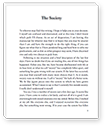Essay Instructions: PSY 6030 Personality Theory and Research
Instructions:
• Create your document with the course number and title, “Midterm short answering”, term and year, and your name at the top.
• Use 1” margins, 12 pt Arial font, and 1.5 line spacing
• For each question you answer, first copy the question number and question into your response document then provide your response below the question.
• Although there is no specific page requirement per answer as it is the content and expression that counts (sometimes longer responses are weaker due to not being clearly to the point) it would be difficult to answer all of these questions well in less than 4-5 pages. Therefore, the total page range could be 4-7 pages.
• Proofread your final document carefully before submitting for organization of thought, quality of written expression, citations and basic technical errors (spelling, grammar, etc).
• Be written in the language, tone and form of a scholarly research articles and book chapters.
• Include complete citations for statements in APA format in text and in a final reference list.
As described in the course syllabus, assessment will focus on the demonstration of the ability to:
• Understand the content and issues addressed in the course material.
• Articulate this understanding clearly and specifically.
• Express this understanding in a professional and scholarly manner.
• Utilize written expression that is at the graduate level regarding content, organization, expression and format.
Assignment Include of Questions Answers
Describe and discuss the basic characteristics, tenets and methods of investigation/research for psychodynamic and cognitive perspectives regarding personality psychology, and the benefits/strengths and limitations/weaknesses of each approach.
Describe and discuss the status regarding the Big Five/Five Factor Model (FFM), cultural context, cross-cultural generalizablity/relevance, and the evidence that pertains to these issues, including related methodological issues for research.
Describe and discuss the issues, research and current status regarding the Big Five/Five Factor Model (FFM) and its applicability and relationships to adjustment problems and psychopathology.
Describe, compare and contrast the Big Five factors and the Big Three factors; the areas of experience, behavior and life that have been found to be related to each; and what relationships have been found in these areas.
Reference
1. John Text: Ch. 3 Psychoanalytic Approaches to Personality
2. John Text: Ch. 4 Paradigm Shift to the Integrative Big Five Trait Taxonomy
3. John Text: Ch. 5 The Five-Factor Theory of Personality
4. John Text: Ch. 6 When is Personality Revealed?: A Motivated Cognition Approach
5. John Text: Ch. 7 Toward a Unified Theory of Personality
6. John Text: Ch. 8 Personal Narratives and the Life Story
7. John Text: Ch. 23 The Psychological Unconscious
8. Monte, C. F. (2000). Personality psychology: Theories. In A. E. Kazdin (Ed.), Encyclopedia of psychology, Vol. 6. (pp. 128-133). Washington, DC, US: American Psychological Association.
9. Westen, D. (2002). Implications of Developments in Cognitive Neuroscience for Psychoanalytic Psychotherapy. Harvard Review of Psychiatry, 10(6), 369-373.
10. Cantor, N. (1990). From thought to behavior: 'Having' and 'doing' in the study of personality and cognition. American Psychologist, 45(6), 735-750.
11. Robinson, M. D., & Gordon, K. H. (2011). Personality dynamics: Insights from the personality social cognitive literature. Journal of Personality Assessment, 93(2), 161-176.
12. Epstein, S. (1998). Cognitive-experiential self-theory: A dual-process personality theory with implications for diagnosis and psychotherapy. In R. F. Bornstein, J. M. Masling (Eds.), Empirical perspectives on the psychoanalytic unconscious (pp. 99-140). Washington, DC, US: American Psychological Association.
13. Dweck, C. (1996). Capturing the dynamic nature of personality. Journal of Research in Personality, 30, 348-362. (Available in ScienceDirect Health & Life Sciences College Edition database)
14. Clark, L.A., & Watson, D. (1995). Constructing validity: Basic issues in objective scale development. Psychological Assessment, 7(3), 309-319. Special Issue: Methodological issues in psychological assessment research.
15. Smith, T. W., & Ruiz, J. M. (2004). Personality theory and research in the study of health and behavior. In T. J. Boll, R. G. Frank, A. Baum, J. L. Wallander (Eds.). Handbook of clinical health psychology: Volume 3. Models and perspectives in health psychology (pp. 143-199). Washington, DC: American Psychological Association.
16. Widiger, T. A., Trull, T. J., Clarkin, J. F., Sanderson, C., & Costa, P. R. (2002). A description of the DSM-IV personality disorders with the five-factor model of personality. In P. R. Costa, T. A. Widiger (Eds.). Personality disorders and the five-factor model of personality (2nd ed.) (pp. 89-99). Washington, DC: American Psychological Association.
17. McAdams, D. P. (1992). The Five-Factor Model in personality: A critical appraisal. Journal of Personality, 60(2), 329-361.
Customer is requesting that (Dmusings) completes this order.
Customer is requesting that (Dmusings) completes this order.
Customer is requesting that (Dmusings) completes this order.


